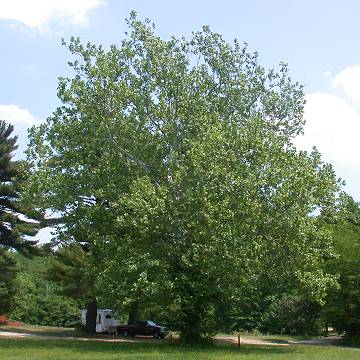

Platanus occidentalis - (image 1 of 8)
Taxonomy
Family: Platanaceae
Habitat
Alluvial plains and stream banks. Frequently planted.
Associates
Acer negundo, Acer saccharum, Betula nigra, Fraxinus pennsylvanica, Gleditsia triacanthos, Juglans nigra, Laportea canadensis, Polygonum virginianum, Salix nigra, Sambucus canadensis, Smilax tamnoides hispida, Ulmus americana.
Distribution
ME to southern MI and southeast MN, south FL to TX.
Morphology
Large deciduous tree to 100' high and wide, with a rounded crown and spreading, massive crooked branches. Leaves alternate, simple, to 9" wide, often wider than long, 3-5 lobed, sinuses shallow, lobes triangular and coarsely toothed; petiole to 5" long, covering the bud; stipules prominent, to 1.5" long, entire or toothed. Bark red to gray-brown and scaly near the base, exfoliating to expose pale white to gray inner layers, like peeling paint. Flowers monoecious; male and female in globose structures on separate peduncles, forming with the leaves. Fruit a round aggregate of achenes, to 1.3" wide, solitary on a 3 to 6" long peduncle.
Notes
Flowers late April to early June
Wetland indicator: Facultative Wetland
This bark of this tree is very interesting in winter, probably it's best ornamental characteristic along with it's impressive size. The fall color is brown, not very showy. A frequently planted hybrid between this and P. orientalis is Platanus x acerifolia, also known as London Plane Tree.
References
Dirr, Michael A. 1998. Manual of Woody Landscape Plants:
Their Identification, Ornamental Characteristics, Culture, Propagation and Uses.
5th ed. Champaign, Illinois: Stipes Publishing L.L.C.
Swink, F. and G. Wilhelm. 1994. Plants of the Chicago Region.
Indiana Academy of Science. The Morton Arboretum. Lisle, Illinois.
|
Michael Hough © 2005 |